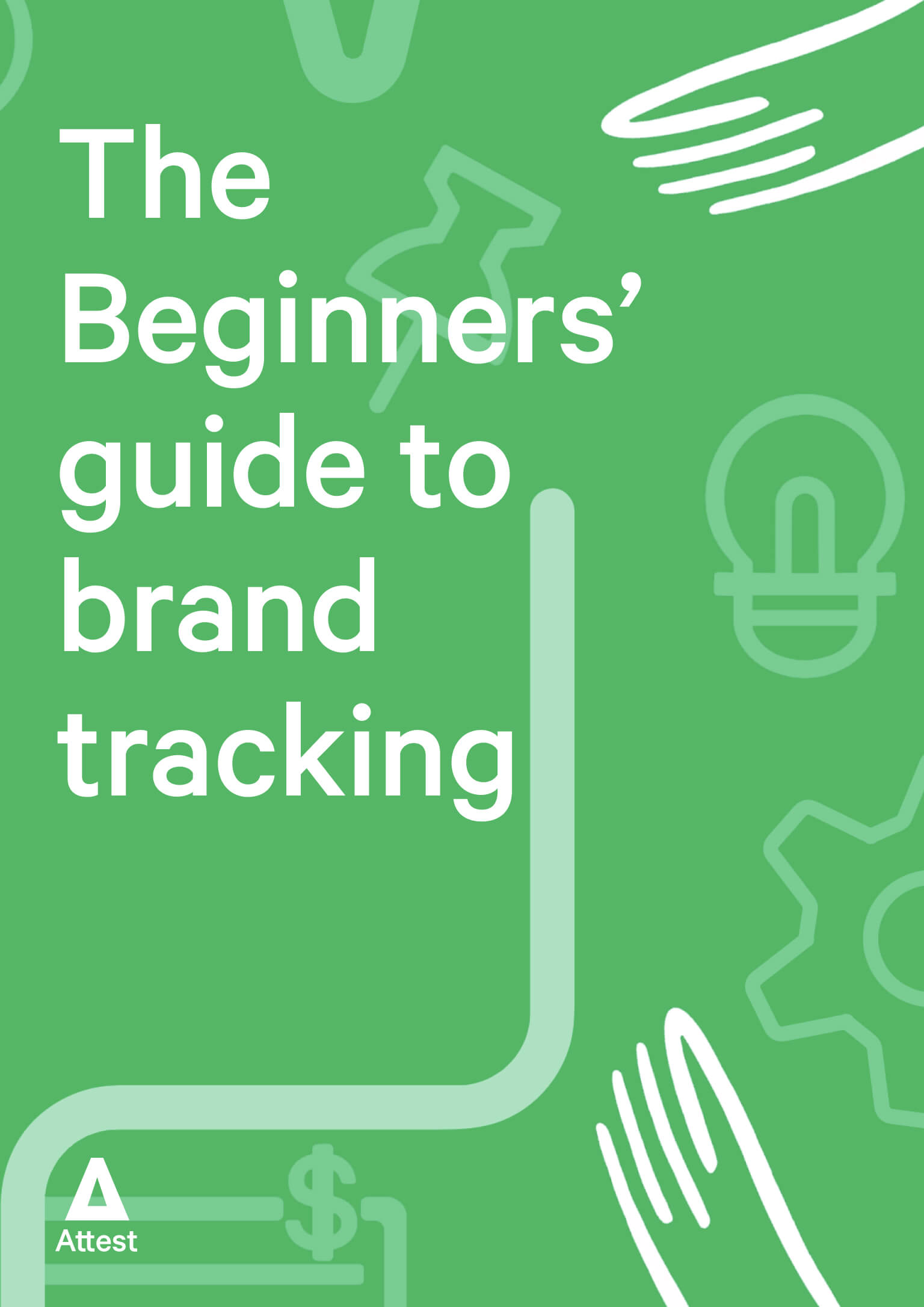A guide to brand tracking: what it is and how to boost your brand ROI

If one of your priorities is to create a real desire for your product or service, then brand tracking can help. We take you through the basics to get started.
What is brand tracking?
Brand tracking is a powerful tool for understanding and measuring your brand’s performance in the marketplace. It’s a process that continuously gathers data over time, helping you to monitor and assess how your brand is perceived by consumers.
By consistently tracking these metrics, you gain invaluable insights to make data-driven decisions, strengthen your brand’s position, and enhance overall marketing effectiveness.
Essentially, brand tracking lets you:
- Measure awareness and visibility of your brand among your target audience.
- Evaluate how your brand stands against competitors in terms of recognition and preference.
- Track changes in consumer attitudes and perceptions towards your brand.
- Assess the impact of marketing campaigns and strategies on brand health.
- Identify opportunities for growth and areas needing improvement.
The importance of brand tracking
Many marketers know that a strong brand and tracking related metrics can make or break a business, but it’s hard to put into words just how strong the impact of ‘brand’ is, as it consists of so many moving pieces. So, let’s look at them individually.
Starting with brand consistency, which simply means showing up in a recognizable way wherever your brand goes. Doing this right can increase revenue by 10-20%. With brand tracking, you can measure how well you’re doing in terms of consistency, and improve.
But it also matters if you’re showing up in the right places. And brand tracking can also give you great insights for that. Take your target audience: Gen Z is shopping more in-stores than online, despite what many people assume.
This just shows that brand tracking isn’t just about measuring how well your brand is doing – it’s about how well it’s connecting to your target audience.
People constantly change the way that they think and perceive the position of brands and businesses, making it important to evolve with the times and keep a close eye on your brand’s relevance as well as your competitors, and adapt accordingly. With our guide to brand tracking, you learn how to do this in a consistent way that can lead to measurable improvements.
While you may have a loyal following of Millennials now, in the not-too-distant future they’ll become the new ‘Gen X’ or ‘Boomers’ – their needs shifting and maturing as their lives evolve. Will your brand grow with them? Or will you be left trying to figure out how to appeal to them?
Without consistent attention, you won’t know how people perceive your brand in comparison to other brands, meaning you could easily be blindsided by a sudden (or even gradual) shift in consumer sentiment, market dynamics or competitor strategy.With brand awareness measurement, you can stay connected to consumers and stay ahead of your competition.
Attest data is key to unlocking richer understanding of our different consumers. It has meant we can think completely differently about segmenting our audience and how we tailor communication to them.
Joanna Christie, Global Brand Director, at Treatwell
How to track your brand (and improve your branding ROI)
Here’s how you can leverage brand tracking effectively:
1. Identify Key Metrics
Start by pinpointing what exactly you want to track. Is it brand awareness, customer loyalty, or perception? And why are these the ones you are interested in? How do they tie in with your KPIs and overall strategy? Knowing what you’ll be measuring and why will set you up for success and lead to data you can act on.
A great example of this is Trustpilot’s approach, who used brand tracking to understand – and then influence – awareness and affinity in 10 global markets. They started out with three big questions:
1. What does Trustpilot’s regional saturation look like, and what is the correlation with affinity in those regions?
2. What levers can be used to impact saturation, awareness, and affinity?
3. Does Trustpilot have the same levels of awareness and affinity year-round, and what are the factors that impact that?
From there on, it was a lot easier to track the right metrics, and it paid off. They launched specific campaigns and actions in different countries to improve their brand health where it needed help the most. Read more about what those campaigns looked like in their case study.
2. Regular surveys and polls
Consistent surveys give you ongoing insights into how your brand is perceived over time.
Conduct Brand Tracking Surveys
Get straight to the source: your customers. Ask them direct questions to gauge their thoughts and feelings about your brand. Here are some key questions to include in your brand tracking surveys:
- How would you describe our brand to a friend?
- On a scale of 1-10, how likely are you to recommend our brand?
- What words come to mind when you think of our brand?
- What improvements can we make to our products/services?
- How well does our advertising resonate with you?
For more in-depth questions, check out our essential questions for brand managers.
Monitor your competitors
Make competitor monitoring a regular activity. Schedule time to review their social media, marketing campaigns, and customer feedback. Which isn’t to say we suggest copying them – this is all about learning and adapting in ways that suit your brand best.
Apart from what they are doing, also keep an eye on how that’s being perceived. Watch for shifts in public opinion and be ready to respond or adjust your strategy accordingly.
Track across multiple channels
Your brand doesn’t live in just one place, and neither should your tracking efforts. From Instagram posts to customer support calls, every interaction tells you something about how your brand is being perceived.
So in addition to surveys, check in on all your other communication channels. This feedback comes straight from the source in a natural and unprompted way and can highlight areas for improvement or potential opportunities for your brand.
Use brand tracking tools
Sure, you could merge together a couple of tools and create spreadsheets and reports manually to track your brand’s health. Or you focus on what really matters and opt for an all-in-one tool that covers the A to Z of brand tracking, from survey design to reporting. It’s a smarter way of using your resources and time, and the results are likely to be a lot clearer.
Here’s how a tool like Attest will be a total game-changer for your brand tracking needs:
- Access to a diverse audience: Attest connects you with over 150+ million people in 59 countries to give you feedback from a broad and diverse audience, offering a more honest and holistic view of how your brand is perceived across different demographics and markets.
- Designated support from research experts: Whether you’re an insights pro looking for a second opinion, or new to research and looking for guidance, Attest’s Customer Research Team is here to help you through your research projects as standard.
- Quick, reliable quant and qual insights: Once your survey is out and the responses roll in, your dashboard will show you comprehensive analytics tools that break down your data into understandable and actionable insights.
To make it an even sweeter deal, you’ll get dedicated support from one of our research experts – no matter which plan you’re on.
Find out more on how to get started here.
Act on the data
It’s not just about collecting data; it’s what you do with it.
An example we love is from The Vegan Society. From their brand awareness study, they learned that 79% of the respondents find it to have vegan products certified by a third-party organization.
The study also revealed that their Vegan Trademark was over 17% more recognized than the second most-recognized vegan certification logo – and was the most trusted of all. They immediately took action and increased their product registrations by nearly 9,000 products, to 56,000.
Iterate and improve
Embrace change as an opportunity. If your tracking uncovers new trends or shifts in consumer preferences, don’t shy away from tweaking your approach. It doesn’t mean you were doing something wrong necessarily – it could simply indicate that something in your target audience has changed, or the market has had an impact. Try to work with it, not against it.
To this end, it can help to set benchmarks and review them periodically. Are you hitting your goals? What’s working, and what’s not? Make brand tracking a part of your workflow and before you know it your marketing ROI will increase – and you eliminate a lot of guesswork.
Communicate your findings internally
These brand insights shouldn’t just be for your marketing team. Product development, sales, customer service – every department can benefit from understanding your brand’s position and perception in the market.
It aligns everyone with your brand’s goals and challenges, fostering a shared commitment to driving your brand forward.
What makes a brand great?
Do you aspire to create a brand that is instantly recognised by its logo, shape or colour, just like Apple’s iconic branding? Or maybe you want to design a brand that has a reputation for high quality and premium products like Waitrose?
Apple and Waitrose are examples of exceptional branding, consistently well executed; and they both come from a deeply rooted marketing strategy with the goal to offer products and services to meet their target consumer’s needs and wants.
Another exceptional brand is Tesla, who are now worth more than GM, despite their vastly smaller revenues and market penetration. Here’s what their founder and CEO says about tracking a brand against consumer expectations:
I think it’s very important to have a feedback loop, where you’re constantly thinking about what you’ve done and how you could be doing it better. I think that’s the single best piece of advice: constantly think about how you could be doing things better.
Elon Musk, Founder & CEO, Tesla
Great brands track what their customers are saying about their products; redesigning their strategy based on this information.
They understand the importance of brand tracking so that they can establish the performance of their brand, discover strengths and weaknesses, understand their place in the market compared to competition, and align their strategy more closely with the expectations of their existing and potential future customers.
Take Audi for example; their cars are so well sought after, their reputation for designing and building robust, high quality, luxurious German cars is pre-eminent. Audi built the first offroad quattro rally car; finding something that someone else was already doing, but managing to do it even better.
These rally cars were winning competition, exposing their cars and technology to the world. As a result, people began to want Quattro technology in their road cars due to its popularity. Audi listened to their audience, and put the same technology from the Quattro rally car into their road cars.
The bottom line is that regularly tracking consumers preferences, and always thinking of ways to make your brand even better, will help you to satisfy, retain and gain more customers.
Questions all Brand Managers should ask their customers
Straight from our in-house team of research experts, here are the top questions you should ask your customers
Get the questionsWhat does brand tracking measure?
There’s no magic number that gives you a complete overview of your brand’s health. Instead, it’s made up of metrics such as the following:
Consumer perception
Understanding how consumers perceive your brand helps you stay on track with your messaging. Brand tracking measures consumer perceptions by gathering feedback on different brand attributes. You can measure how consumers perceive your brand’s quality, reliability, and value – and much more.
It is not about finding out if consumers are ‘wrong’ about your brand, it’s about finding out how you can communicate effectively. ‘Measuring’ perception helps you see areas where perception may be misaligned with your branding goals. Should you double down on something? Should you shift your messaging?
Make sure to keep tracking changes in perception over time, so you can effectively navigate shifts in market trends and consumer attitudes.
Brand awareness
Brand awareness is about how familiar your target audience is with your brand. Tracking this metric reveals how effectively your brand cuts through the market noise.
It measures recognition (can consumers identify your brand when prompted?) and recall (do consumers think of your brand spontaneously?).
High awareness often correlates with market share and can be a predictor of business growth. Regular tracking allows you to evaluate the effectiveness of your marketing campaigns and adjust your strategies to boost your brand’s visibility and recognition.
Brand loyalty
Brand loyalty isn’t merely measured by counting all repeat purchases; it’s about the emotional connection customers have with your brand.
Tracking brand loyalty involves measuring customer satisfaction, likelihood of repeat purchases, and willingness to recommend your brand to others.
This metric is crucial. Because a loyal customer base not only ensures steady revenue but also turns customers into brand ambassadors. It’ll make your marketing more effective and efficient. Understanding where loyalty to your brand comes from allows you to enhance customer experiences, nurture long-term relationships, and increase customer lifetime value.
Brand preference
Brand preference measures the degree to which consumers choose your brand over competitors.
It’s an indicator of your brand’s strength in the market. Brand tracking helps you understand why consumers prefer your brand, whether it’s due to perceived quality, price, or emotional connection.
By analyzing preference trends, you can identify your brand’s unique selling points, fine-tune your value proposition, and strategically position your brand to outperform competitors. It’s about capturing not just the market share, but the mindshare of your consumers.
Put consumer perception at the core of your brand tracking efforts
Tracking your brand is invaluable in building a strong marketing strategy and growing your business to develop into a market leading brand. Clever marketers know that the most valuable source of information about their brand, are the thoughts and feelings of their target consumers.
Keeping track of what people are saying about your brand, whether it is good or bad, helps you to get grounded by real insight and spark your creativity to deliver the best results for your brand.
With direct to consumer brand tracking, it is easier than ever to reveal, analyse, and test findings to uncover the ‘why’ behind results and dig deep into the drivers of consumer emotions by asking them questions.
And by using a platform like Attest, it takes the stress, cost and time out of this vital consumer research.
Brand tracking goes beyond tracking clicks and online data (which is often hampered by ad blockers, complex tracking, expired cookies, bot traffic etc.) to provide essential insights from verifiably real people, on how they use your brand and what they think and feel about the experience.
Brand tracking gives you the opportunity to dig deep into the most intricate of details, helping you to identify where you are losing customers along the way, and why.
For example, online payments startup Patreon recently had to reverse a planned change to it’s pricing structure after a backlash from existing customers, many of whom left the service.
Uber also suffered a bad year, with the hashtag #deleteuber trending, while high profile missteps from Dove and Pepsi both made headlines.
While all of these top brand examples were of such a magnitude that brand tracking wasn’t necessary to register discontent, how many decisions might you make that could have a similar impact with a less obvious response?
A pricing update (Patreon), new policies (Uber), changes to packaging (Dove), an off note marketing campaign (Pepsi) may not put your company in the news, but they could easily cost you customers (and market share), or simply hamper future growth, if you’re not aware of the impact and why consumers have become discontent.
FAQs
Brand tracking is a method to measure your brand’s performance in the eyes of your audience. It involves assessing awareness, perception, and loyalty, giving insights into your brand’s current position and potential future direction.
The frequency of brand tracking depends on the dynamics of your market and audience behaviors. Typically, conducting it quarterly is effective, but the key lies in maintaining a consistent schedule to monitor your brand’s health. If you’re planning on rebranding or recently have, or have launched significant campaigns, brand tracking is also a great idea.
A combination of methods, including surveys, social media listening, and competitor analysis, usually works well. Tools like Attest can simplify and enhance this process, providing valuable insights efficiently.
While market research focuses on broader market trends and consumer behaviors, brand tracking specifically measures public perception and interaction with your brand. Both are important for a comprehensive business strategy.
Take your brand tracking to the next level with Attest
This brief introduction to brand tracking is the first part of our more in-depth guide to brand tracking. In our guide to empowering your teams to do brand tracking in-house, we’ll also dive into:
- The advantages of brand tracking in-house
- An extended brand tracking template designed for deep diving into the competition
- How to squeeze more insights from your brand tracking data
- Brand tracking case study from Trustpilot
- Brand tracking tools
How’s your brand’s awareness?
Find out how many people know about your brand and what they think about it with our audience of 150+ million people in 59 countries
Measure your brand awarenessTell us what you think of this article by leaving a comment on LinkedIn.
Or share it on:

